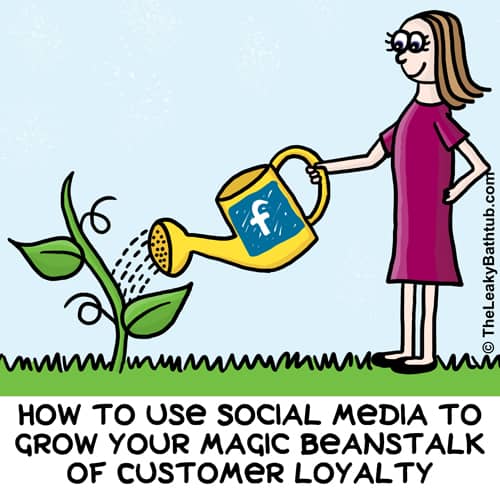 Hello, my name’s Cornelia and I’ve been a Facebook user since 2007.
Hello, my name’s Cornelia and I’ve been a Facebook user since 2007.
Yes, it’s true, I’m a long-time Facebook user. I’ve had Facebook business Pages since 2008. And you can also find me on Twitter, LinkedIn, and Pinterest. In fact, at the time of writing, I’ve got 4 Twitter profiles and 4 Facebook Pages, each for a different brand of my business (because each brand has a different target market).
That doesn’t mean that I love social media as a business tool
So you might be surprised that I have reservations about social media as a business tool. You might (wrongly) assume that I’ve jumped on the hype bandwagon.
Here’s the thing… I’ve used social media to test and measure things. And I’ve learned some important lessons that I’m going to share here with you.
1. Social media only works as a business tool if your customers and prospects are using it too
Before you decide that you’re going to use Facebook or Twitter or LinkedIn or whatever, make sure that your audience is actually using it too! I’ve seen too many business owners jump in, and engage in a nice conversation… with themselves.
Or other times they’ve started using (for example) Twitter… but their audience doesn’t use Twitter, they’re over at LinkedIn.
Talking to yourself gets pretty boring after a while, so do some research first!
2. Not everyone will see your updates
No matter which social media site you’re using, not all of your followers will see your updates.
For one thing, social media requires users to actually log in and check for updates. So if your audience is busy, they won’t see your posts.
What’s more, social media news feeds move fast. Depending on how active your contact is, anything more than an hour or two old won’t get seen.
And on top of this, your Facebook Page will only be seen by 10-20% of your fans… unless you pay Facebook to promote your updates.
3. You need to be comfortable using social media
It is soooooo obvious when a business owner isn’t comfortable with social media. The updates are generally sporadic, uninteresting, stilted and not engaging. (And remember, the whole point of this social media malarkey is to engage and interact.)
You either need to learn to get comfortable with it, or get someone who loves it (and understands your business inside out) to write the updates for you.
4. Check your profile regularly
Here’s another reason why you should love social media if you’re going to use it as a business tool: you need to check your profile regularly.
If a follower makes a comment on your page, or asks you a question, it’s a really bad look for your business if you don’t reply promptly. That can do more damage to your business reputation than it can do good. So if you can’t check your profile regularly (and respond as needed), it may be best to leave social media alone.
After all, it is called ‘social’ media… not ‘unsocial’ media. 😉
5. Commit to making regular updates
To keep readers engaged, you need to make updates regularly.
So what is ‘regularly’? In my years of using Facebook Pages and Twitter, I’ve found that I need to make one update daily to keep people engaged. Any less than that, and things start stagnating. (i.e. no new followers/likes, not many website click-throughs.)
You may also need to experiment with different days of the week. For example, I usually post Monday to Friday on Facebook. I experimented with posting at weekends too, but those weekend posts didn’t get seen, as my followers were busy doing other things.
But on Twitter, the most important time for me to post as Minnie The Westie (my cartoon dog) is at weekends, either early morning or in the evening. My audience is either in the UK or US, and they tend to check their accounts at the weekend more than during the week.
6. Posting quality content is vital
Regularly posting quality content is important to keep your readers engaged, yet this is something that many small business owners really struggle with.
Again, it comes down to having a love for social media. You can learn a lot by seeing what others are posting, and what kind of responses they get.
It’s also a balancing act between promotional posts and other (fun) stuff; you need to strike a balance. Aim to make no more than 5% to 10% of your posts promotional. And keep your content varied.
For example, on Facebook that means a mix of links to articles; posting photos (that you have copyright of); links to videos; and so on.
7. If you’re a service business, you need to understand the limitations of social media
If you’re in a service business that offers one-on-one help, you need to be aware that people are buying you, not your business. That means that trust is really important… and it’s almost impossible to build that trust through social media alone.
Your website can help to build trust. But if you’re in a service business, word of mouth referrals are your key new business tool. So don’t expect social media to bring you an army of new customers: that’s very unlikely. Treat social media as a customer retention tool (if your customers are using social media, etc.).
It’s even hard to grow your Facebook ‘likers’ when you’re a service business. Think about it: have you ‘liked’ any service businesses that you haven’t personally used or met? Chances are, that when you’re a service business, most of your ‘likes’ will be from friends, colleagues, clients, and strategic alliance partners. And that’s OK: quality is more important than quantity.
It’s a bit different when you’re selling a product; there’s less perceived risk. People can return a product if they don’t like it. Product sales aren’t usually so personal.
Example: I’ve sold a good amount of Minnie The Westie cartoon dog books because of my social media work; but I’ve never (so far!) received a copywriting or marketing consulting client through my social media work. But that’s okay. The copywriting and consulting has a longer, more involved sales process. And it’s got a higher price tag than a $20 cartoon book.
So just keep things in perspective, and remember that quality is more important than quantity. 🙂
8. To attract new customers via social media, you will need to invest a lot more time and/or money
Just because I haven’t made copywriting or consulting sales through social media doesn’t mean that it’s not possible. It just means that my one-post-a-day approach isn’t enough.
You can make sales through social media. But it requires a far greater investment of time and/or money. For example, you may need to pay to promote your updates. Or pay for Facebook ads.
That’s a whole different ball game. And personally, it’s one I’ve chosen not to play (so far). Why? My target market clients aren’t great users of social media. Yes, my strategic alliance partners are on social media, but not my target customers. And there’s no point paying for advertisements to my strategic alliance partners when I can engage with them in other ways that are more personal and make a greater impact.
9. You need to test and measure how you’re doing
If you do use social media, check your Google Analytics to see how much traffic the different sites are sending you, and how engaged those users are. Metrics such as ‘time on site’, ‘bounce rate’ and ‘pages per visit’ are important here.
For me, I’ve found that Facebook users tend to be more engaged than Twitter users. (Even for Minnie The Westie, where I’m far more active on Twitter than Facebook.) Yet I’ve made sales to both Facebook and Twitter users.
As for Pinterest? In my view, it’s not worth the bother. The click-through rates are low, and Pinterest users are browsers, not buyers.
So how can you use social media as a customer retention tool?
Despite all my social media myth-busting, you can use it as an effective customer retention tool. I just think it’s important to be realistic about social media, because so many of the so-called ‘gurus’ are toting it as the latest and greatest thing ever. Sure, it has its uses (and, of course, it’s free!) but when you’re a small business owner with limited resources, you need to keep things real.
If you take heed of the tips above, social media can be a great way to get your clients to climb the magic beanstalk of customer loyalty.
Why? Because if you use social media well, it can not only keep your raving fans engaged (and give them material to rave about), but it can even help create more raving fans… provided you dazzle them with your awesome updates.
Here’s how you can use social medial for your customer retention campaigns:
1. Offer value-added tips
Do you have website or blog articles that your clients will find useful? Then link to them from your social media profiles!
(Just like I’ll be linking to this article from my Facebook Page, Twitter account and LinkedIn profile.)
Tip: if you have a specific customer that will find your article useful, but isn’t on social media, then send them the link in a personal email. That’s another way you can stay in touch, and they’ll appreciate the fact that you thought of them.
2. Use social media as a customer service tool
Social media isn’t about you or your brand; it’s about your customers. It’s a tool for two-way communication… and every so often you might encounter a customer with a complaint or problem.
So how should you handle customer complaints made via social media?
For one thing, you need to check your social media profiles regularly, to keep on top of things. Replying promptly is important: the sooner you can nip any issues in the bud and rectify them, the better. It’s important to view any complaints as an opportunity to put things right. Always be professional and courteous – even if the customer isn’t acting this way… remember, you have an audience watching.
If a customer does get angry or abusive, communicate via email or direct messages (via the social media platform). There’s no need to wash that dirty laundry in public!
Customer complaints are an opportunity to gain customer loyalty
Yes, it’s true: customer complaints can actually help clients climb the magic beanstalk of customer loyalty!
Statistics show that 7 out 10 people who’ve had a complaint resolved fairly will continue to do business with that company. Using social media as a customer service tool is a great PR tool to create positive publicity, provided you do it well.
(No, I’m not saying that you should get people to complain on purpose; but if they do, see it as an opportunity rather than a complete negative.)
Note: don’t think that by avoiding social media you can avoid negative publicity. People will still talk about you; the difference is that if you’re part of the conversation you have a greater chance of influencing the outcome in a positive way.
3. Share customer news, success stories and articles
Use your social media profile to share your customers’ successes! They will appreciate the fact that you’re helping to promote them.
You can do this whether you client is on social media or not. If they are on social media, then sharing their updates is quite easy (with the share or Retweet function), and they’ll see that they’ve done this.
If they’re not on social media, write your own update, and link to their website (if that’s appropriate). And tell the customer that you’ve promoted their business. After all, if you’re going to do something nice for your customer, you might as well tell them about it, so that they can appreciate you!
4. Make important announcements
Got something new, different or interesting to announce? Post it on your social media profile! Blow your own trumpet every now and again! (Just don’t do it too often, as that’s very off-putting.)
However, don’t rely on social media alone. Not everyone will see your announcement on social media, and if you don’t make any other attempts to communicate it (a) your announcement will fall flat, and (b) that’s very lazy.
If you’ve got a new product, or some other special announcement, you need to tell your customer base (and your strategic alliance partners) in a more personal way. Consider email or mail – or, better still, both.
5. Drive traffic to your own website and build your own opt-in list
Work at putting quality information on your own website, and encourage your followers to click through to your site. Most importantly of all, get them to sign up to your own email opt-in list while they’re there.
Why bother doing that when they’re already following you on social media?
It’s very dangerous to build your business on someone else’s property. And if you’re relying on social media to connect you with your clients and prospects, you’re building your business on very dangerous territory, my friend.
You don’t own Facebook or Twitter or LinkedIn. They could disappear overnight… and where would you be then?
Or they might change their rules. (Just look at how often Facebook makes changes, and each time they do there’s a lot of grumbling from users, and people closing their accounts.) You have no control over this. And you absolutely must have control of your client and prospect list. So getting these opt-ins is vital to the continued health and success of your business.
Whilst social media is an okay tool for customer retention, email marketing is a great tool for customer retention. I’ll cover the ins and outs of email marketing later in this series. 🙂
Summary
- Before you dip into the world of social media as a business tool, there are certain things you need to be aware of:
-
- Social media only works as a business tool if your customers and prospects are using it too
- Not everyone will see your updates
- You need to be comfortable using social media
- Check your profile regularly
- Commit to making regular updates
- Posting quality content is vital
- If you’re a service business, you need to understand the limitations of social media
- To attract new customers via social media, you will need to invest a lot more time and/or money
- You need to test and measure how you’re doing
- You can use social media as a customer retention tool in the following ways:
-
- Offer value-added tips
- Use social media as a customer service tool
- Share customer news, success stories and articles
- Make important announcements
- Drive traffic to your own website and build your own opt-in list
- It is dangerous to rely too much on social media, as you have no control over it. Focus on growing your own opt-in list so that you have maximum control.



